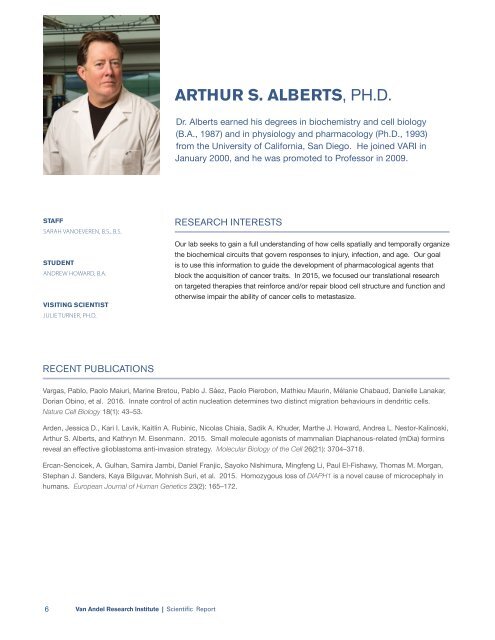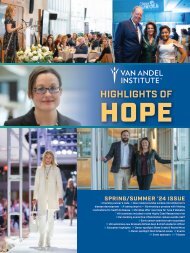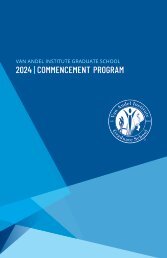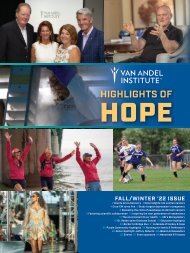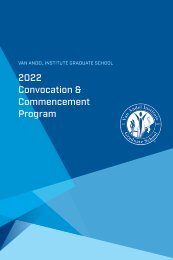2016 Scientific Report
Create successful ePaper yourself
Turn your PDF publications into a flip-book with our unique Google optimized e-Paper software.
ARTHUR S. ALBERTS, PH.D.<br />
Dr. Alberts earned his degrees in biochemistry and cell biology<br />
(B.A., 1987) and in physiology and pharmacology (Ph.D., 1993)<br />
from the University of California, San Diego. He joined VARI in<br />
January 2000, and he was promoted to Professor in 2009.<br />
STAFF<br />
SARAH VANOEVEREN, B.S., B.S.<br />
STUDENT<br />
ANDREW HOWARD, B.A.<br />
VISITING SCIENTIST<br />
JULIE TURNER, PH.D.<br />
RESEARCH INTERESTS<br />
Our lab seeks to gain a full understanding of how cells spatially and temporally organize<br />
the biochemical circuits that govern responses to injury, infection, and age. Our goal<br />
is to use this information to guide the development of pharmacological agents that<br />
block the acquisition of cancer traits. In 2015, we focused our translational research<br />
on targeted therapies that reinforce and/or repair blood cell structure and function and<br />
otherwise impair the ability of cancer cells to metastasize.<br />
RECENT PUBLICATIONS<br />
Vargas, Pablo, Paolo Maiuri, Marine Bretou, Pablo J. Sáez, Paolo Pierobon, Mathieu Maurin, Mélanie Chabaud, Danielle Lanakar,<br />
Dorian Obino, et al. <strong>2016</strong>. Innate control of actin nucleation determines two distinct migration behaviours in dendritic cells.<br />
Nature Cell Biology 18(1): 43–53.<br />
Arden, Jessica D., Kari I. Lavik, Kaitlin A. Rubinic, Nicolas Chiaia, Sadik A. Khuder, Marthe J. Howard, Andrea L. Nestor-Kalinoski,<br />
Arthur S. Alberts, and Kathryn M. Eisenmann. 2015. Small molecule agonists of mammalian Diaphanous-related (mDia) formins<br />
reveal an effective glioblastoma anti-invasion strategy. Molecular Biology of the Cell 26(21): 3704–3718.<br />
Ercan-Sencicek, A. Gulhan, Samira Jambi, Daniel Franjic, Sayoko Nishimura, Mingfeng Li, Paul El-Fishawy, Thomas M. Morgan,<br />
Stephan J. Sanders, Kaya Bilguvar, Mohnish Suri, et al. 2015. Homozygous loss of DIAPH1 is a novel cause of microcephaly in<br />
humans. European Journal of Human Genetics 23(2): 165–172.<br />
6<br />
Van Andel Research Institute | <strong>Scientific</strong> <strong>Report</strong>


